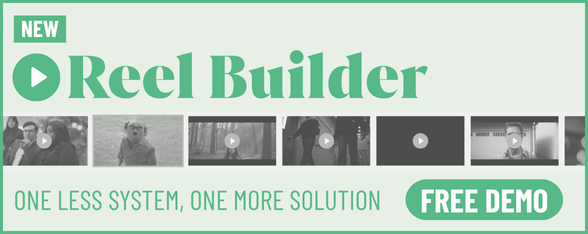
AI and the Value of Real Time Creativity

Lucas Stanley is a writer-director and AI creative lead at Jellyfish, shaping the future of storytelling at the intersection of technology and film.
With a background in cinematography, he brings a visually sophisticated and conceptually sharp approach to his work, crafting compelling narratives for global brands like Google.
His expertise in AI-driven creative production extends to thought leadership, where he develops frameworks and strategies to help brands harness AI with clarity and impact.
Passionate about distilling complex ideas into simple, powerful executions, he pushes the creative boundaries while staying rooted in human-centred storytelling, whether through AI films, brand storytelling, or experimental projects.
LBB> What’s the most impactful way that AI is helping you in your current role?
Lucas> In honesty, it’s totally changing the way we work with clients. We build with them in real time, quickly creating ideas and seeing how things would look. So we’re seeing the value of real-time creativity get a real boost. And as a result, there’s an enhanced focus on culture, both externally and for the brands we’re working with.
LBB> We hear a lot about AI driving efficiencies and saving time. But are there any ways that you see the technology making qualitative improvements to your work, too?
Lucas> Absolutely. The tools as they are can make imagery that feels premium and, above all, real. But while a lot of focus is on visual generation tools, it also opens up entirely new ways of marketing: always-on hotlines that bring to life brand characters and copy lines that address specific streets. That kind of stuff simply wasn’t possible before.
LBB> What are the biggest challenges in collaborating with AI as a creative professional, and how have you overcome them?
Lucas> It just says ‘no’ quite a lot. Or yes, but not quite what you want. So often, something will be 95% right, but getting the last 5% becomes impossible. Which is where traditional post-production comes in. The other challenge is that it tends to want to do things it’s seen more of. It’s such a fun tool for exploration, but if you let it lead too much, you quickly end up with derivative work.
LBB> How do you balance the use of AI with your own creative instincts and intuition?
Lucas> I’m a director and am used to working with large crews. It feels very similar. I lead and keep us moving towards an original vision. But I’m also open to suggestions that make the output better. AI is similar. It makes as many suggestions as you ask it to. I listen to and integrate as many of the good ones, as many as I can without letting that overrun my original vision.
LBB> And how do you ensure that the work produced with AI maintains a sense of authenticity or human touch?
Lucas> Authenticity and human touch are brilliant north stars. But they’re really hard to quantify.
I’d never ask someone working on my projects to make something more authentic, because that’s not a direction you can easily follow.
Instead, I may say we need to hear more about where our lead came from. We need to look at more reference footage from the original era to get closer to it. Actionable things. It’s the same for AI.
Authenticity and human touch are ultimately emotional – they’re feelings. It’s our job as creative leaders to understand the components that create those feelings, and then bring them into our work, no matter the medium.
LBB> Do you think there are any misconceptions or misunderstandings in the way we currently talk about AI in the industry?
Lucas> 100%. We focus on the good, and the wow, because those things get headlines.
That makes a lot of people scared for their jobs, and a lot of others scared that they’re being left behind. But for any professional working with it, it’s a complex, evolving, and extremely challenging field. Prompting is an entirely new skill set. The outcomes are entirely new, and can be extremely impressive.
But we’re really trying to answer questions like ‘is this a strategic tool, what creative can we do with it, should this sit in production?’. I love AI, and work with it day in and day out. It feels super creative and playful. But if you want to make great work, it definitely isn’t easy.
LBB> What ethical considerations come to mind when using AI to generate or assist with creative content?
Lucas> All of the popular ones – copyright, originality, the impact on existing industries, the environmental impact, the unbalanced representation in its un-guided output… but the one that I see on the horizon as really complicated comes when we start using real people's likeness in AI video.
Anyone could prompt that likeness to do anything – which opens up a wealth of questions about who should prompt who. Can someone from a privileged background really prompt the likeness of someone from a marginalised background in a way that’s faithful to that person’s lived experience? There are so many questions like this that require real care and nuance to navigate.
LBB> Have you seen attitudes towards AI change in recent times? If so, how?
Lucas> Absolutely. As more creatives get their hands on more capable models (looking at you, Veo 2), the level of excitement really grows. It’s a lovely thing to see.
LBB> Broadly speaking, does the industry’s current conversation around AI leave you feeling generally positive or generally concerned about creativity’s future?
Lucas> There’s a lot of fear. That’s always bad for creativity. But ultimately, I feel really positive. AI hasn’t magically made people forget what ‘good’ is. I feel fear for traditional production, and I feel worried about people entering the industry without routes like that. But ultimately, creativity is a competitive market, and even with new mediums, we have the same pressures to make great work that stands out. And that takes real creativity.
LBB> Do you think AI has the potential to create entirely new forms of art or media that weren’t possible before? If so, how?
Lucas> I do. As I said above, a lot of the exciting stuff comes from the entirely new aspects of AI, not just what AI can replace. It can be always on. It can understand trends in ways that were impossible before. It’s a whole new demographic whose opinion of our products influences everyone else.
We can build characters in minutes, make visuals in any style we want, and create films that were impossible before. My agency has a few tools (Pencil, Share of Model and Social Agents) that have genuinely opened my mind to what the future of marketing looks like. And it is not the same.
LBB> Thinking about your own role/discipline, what kind of impact do you think AI will have in the medium-term future? To what extent will it change the way people in your role work?
Lucas> I’m an AI creative, so it’s affected me hugely – my role didn’t exist two years ago. The main impact I see is that we’ll work faster and freer and involve clients way more. In my mind, AI is at its best when the creative and production processes become one – although there will always be a need for the time to craft.















